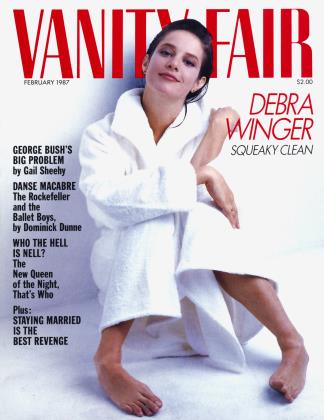Sign In to Your Account
Subscribers have complete access to the archive.
Sign In Not a Subscriber?Join NowA TOUCH OF GLASS
From flutes to snifters, the simplest glasses are clearly better
JOEL L. FLEISHMAN
Wine
There is a great deal of silliness and excessive fussiness about choosing exactly the "right" glass for different kinds of wine. The pretentiousness is similar to that of those who would rather be found dead than in violation of the "rules" for matching wines with food. This is not to suggest that some glasses do not improve the taste, smell, and look of the wines they contain. Without question, they do. But it is far better to own one well-chosen glass for all wines than to compromise on quality in order to increase diversity.
If one wishes to buy only one sort of glass, what should its characteristics be? Well, it should be large enough to contain at least six ounces of wine, so as to permit a generous serving while leaving sufficient room to aerate the wine by swirling. One cannot bring the full flavor out of wine without swirling, and one cannot swirl a small glass without splashing wine in a sloppy and untidy way. Most wine professionals prefer an elongated tulip-shaped glass, with a bowl about four to five inches deep, which facilitates both aeration and viewing of the wine. If there is a slight inward slope toward the top of the glass— if the mouth of the glass is narrower than its waist—the wine's bouquet will be more concentrated, more closely focused for appreciation by the nose. The slight inward slope will also deter errant splashes during swirling. Such glasses are suitable for all kinds of wine, and are available in both glass and fine crystal. Just remember to stay away from colored glass, and glasses that are decorated with painted designs. They hinder examination of the color and clarity of the wine itself. Etched crystal has the same disadvantage.
For those who can afford the extravagance of a variety of wineglasses, and who have room to store glasses of differing heights, widths, and shapes, there are many aesthetically pleasing, functional glasses that do enhance the pleasure of particular wines. Champagne and other sparkling wines, for instance, are best served in long-stemmed glasses with a bowl four to five inches deep. A slender, tapered glass greatly increases the pleasure of sparkling wine by enabling one to watch the golden air bubbles float upward in strands through the entire length of the glass. For that reason, the shallow "champagne cocktail" goblets, modeled, it is said, on the form of a woman's breast, are utterly unsatisfactory. Goblets shaped like a thin, elongated tulip are my favorite, especially the graceful, gently curving Baccarat goblet in the St. Remy pattern. It costs about $40, and is available from Baccarat, 55 East Fifty-seventh Street, New York, New York 10022 (212-8264100), and in many department stores.
For white wine, I like a full-size, broad-waisted tulip glass capable of holding about twelve ounces of wine. My choice, again, is the Baccarat St. R6my, in the water-goblet size, at $50. My all-time favorite red-wine glass is the Baccarat Tastevin, a perfect sphere with the top fifth sliced off. It sells for about $67.50. A less expensive version of the same glass, in Yugoslavian crystal, is available as part of the SherryLehmann collection (available only at Bloomingdale's). A set of four costs $30. While not as heavy, well balanced, or elegant as the Baccarat, and with slight irregular variations in shape from glass to glass, the Sherry-Lehmann glasses are equally functional. The Tiffany all-purpose wineglass is similar in shape but without as much inward slope. A set of four costs $44.
The Sherry-Lehmann collection includes 8-ounce, 12-ounce, 16-ounce, and 20-ounce wineglasses, 6.5-ounce and 9ounce champagne flutes, a giant 21ounce brandy snifter as well as a more discreet 12-ounce version, and a 4ounce sherry glass. The 8-ounce wineglass is the most nearly perfect inexpensive glass I know of for serving dessert wine or port. It focuses the rich, sweet bouquets, and its sloping sides make for perfectly safe swirling. It also looks beautiful alongside its larger siblings.
Decanting wine is necessary only if there is sediment in the wine or if a long period of aeration is advisable. Serving wine from a decanter, however, can add to the aesthetic pleasure of dinner at a nicely set table, and can be useful if one wishes one's guests to believe that the wine cost more than it really did. A widemouthed decanter, carafe, or flask is the most functional, because the wine can be easily poured into it without a funnel. It is best to buy a decanter that will hold at least fifty-six ounces of wine. Here again, simpler is better, and clarity of the glass is essential. For sheer elegance and grace, however, the best decanter I've ever seen is the Pavot from Baccarat, which costs $200 and holds thirty-five ounces. It has a long, swanlike neck that rises a seemingly endless distance from its rounded, pear-shaped bottom. Alas, its mouth, like that of most crystal decanters, is narrow, so one must sacrifice utility for the sake of elegance. It must be special-ordered, and takes about six months to arrive. □
 View Full Issue
View Full Issue


















Subscribers have complete access to the archive.
Sign In Not a Subscriber?Join Now